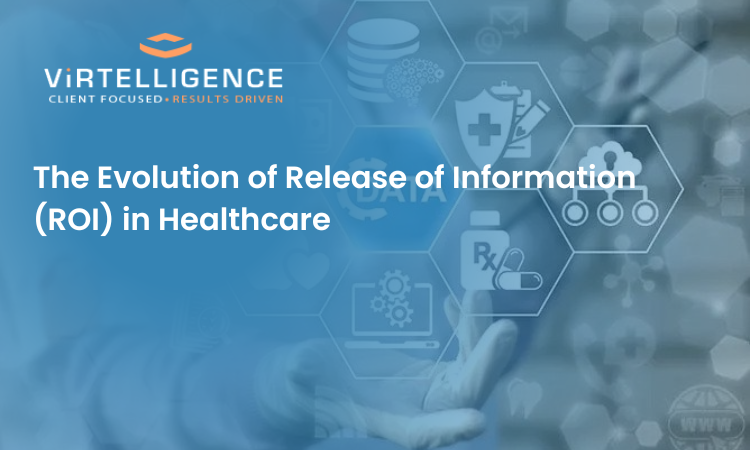
In the current era of healthcare, the release of information (ROI) has become increasingly important for healthcare providers, patients, and other stakeholders. The process of ROI involves the disclosure of patient health information to authorized individuals or organizations. The main objective of ROI is to ensure that patients’ privacy and confidentiality are protected while allowing for the appropriate sharing of information to enable effective patient care. Over the years, the release of information processes has undergone significant changes, with the emergence of new technologies and the adoption of new regulations. In this article, we will discuss how the release of information processes is changing and the impact of these changes on healthcare providers, patients, and other stakeholders.
What is ROI and how is it changing?
Release of Information (ROI) is a process that authorizes the sharing of medical records or patient information between healthcare providers or authorized third parties. ROI is not just limited to sharing information on medical procedures or diagnoses but encompasses all aspects of patient information, including lab reports, imaging results, medication lists, and more. There are two types of releases in the ROI process – authorized releases to third parties and releases that do not require patient authorization to complete, such as Treatment, Payment, and Operations (TPO) activities. While authorized releases to third parties require patient consent or authorization, TPO activities do not. However, healthcare organizations must comply with all applicable regulations, and patient privacy and data security must be protected during the release process.The Health Insurance Portability and Accountability Act (HIPAA) and the Health Information Technology for Economic and Clinical Health (HITECH) Act are two key regulations that govern the release of health information in the United States. Currently, most states have a 30-day turnaround time requirement for releasing medical records to patients, with some states requiring a shorter turnaround time. As patient access to healthcare information becomes increasingly important, it is likely that these requirements will evolve to support faster access to records.
Shift from Paper-based to Electronic ROI
One of the significant changes in the release of information process is the shift from paper-based to electronic ROI. With the increasing adoption of electronic health records (EHRs) by healthcare providers, the release of information processes has become more streamlined, efficient, and secure. Electronic ROI allows for the secure sharing of patient health information between healthcare providers, patients, and other stakeholders. In addition to the efficiency and security benefits, electronic ROI also enables healthcare providers to comply with the regulations regarding the release of patient health information, such as the Health Insurance Portability and Accountability Act (HIPAA).
Increased Focus on Privacy and Security
Another significant change in the release of information process is the increased focus on privacy and security. With the increasing threats of cyberattacks and data breaches, healthcare providers and patients are becoming more aware of the importance of protecting patient health information.To address these concerns, healthcare providers are adopting more robust privacy and security measures to protect patient health information. For instance, healthcare providers are using secure electronic systems to transmit patient health information, implementing access controls to ensure that only authorized individuals have access to patient health information, and training staff on the importance of privacy and security.Furthermore, regulations such as HIPAA and the General Data Protection Regulation (GDPR) require healthcare providers to implement measures to protect patient health information. Failure to comply with these regulations can result in significant penalties and reputational damage.
The Role of Patients in the Release of Information Process
In the past, the release of information was mainly controlled by healthcare providers. However, with the increasing awareness of patients’ rights to access their health information, patients are becoming more involved in the release of information processes. Under HIPAA regulations, patients have the right to access their health information and request that their health information be shared with other healthcare providers. Patients can also request that their health information be amended if they believe that the information is incorrect. As patients become more involved in the release of information processes, healthcare providers need to ensure that patients’ privacy and confidentiality are protected while allowing for the appropriate sharing of information.
Impact of Changes on Healthcare Providers
The changes in the release of information process have significant implications for healthcare providers. Healthcare providers need to adopt new technologies, such as EHRs, and implement robust privacy and security measures to comply with regulations and protect patient health information. Furthermore, healthcare providers need to educate their staff and patients on the importance of privacy and security and ensure that patients’ rights to access their health information are respected. Failure to comply with regulations or protect patient health information can result in significant penalties and reputational damage.
Strategies To Apply
To support a “no barriers” approach to patient access, healthcare organizations will need to implement changes in their ROI processes. The following are some strategies that can be employed to support this approach:
- Implement Electronic Health Records (EHRs) and Patient Portals to provide patients with easy and convenient access to their health information.
- Provide Secure Data Sharing platforms that comply with regulatory standards to ensure that patient privacy and data security are protected.
- Establish Clear Policies and Procedures for record-sharing to promote consistency and efficiency in the ROI process.
- Distinguish between a Designated Record Set (DRS) and a Legal Medical Record (LMR) when preparing to release patient information.
Conclusion
In conclusion, the release of information processes is changing, with the shift from paper-based to electronic ROI, increased focus on privacy and security, and the role of patients in the process. These changes have significant implications for healthcare providers, patients, and other stakeholders. Healthcare providers need to adopt new technologies, implement robust privacy and security measures, educate their staff and patients, and ensure compliance with regulations to protect patient health information while allowing for the appropriate sharing of information.






